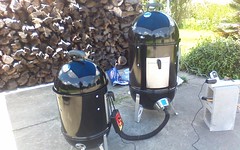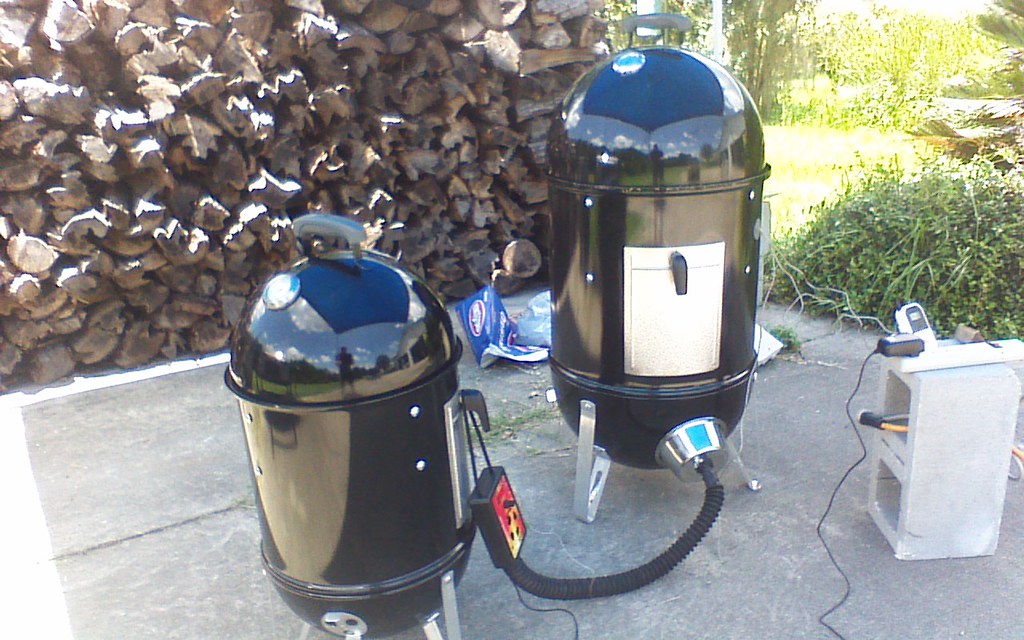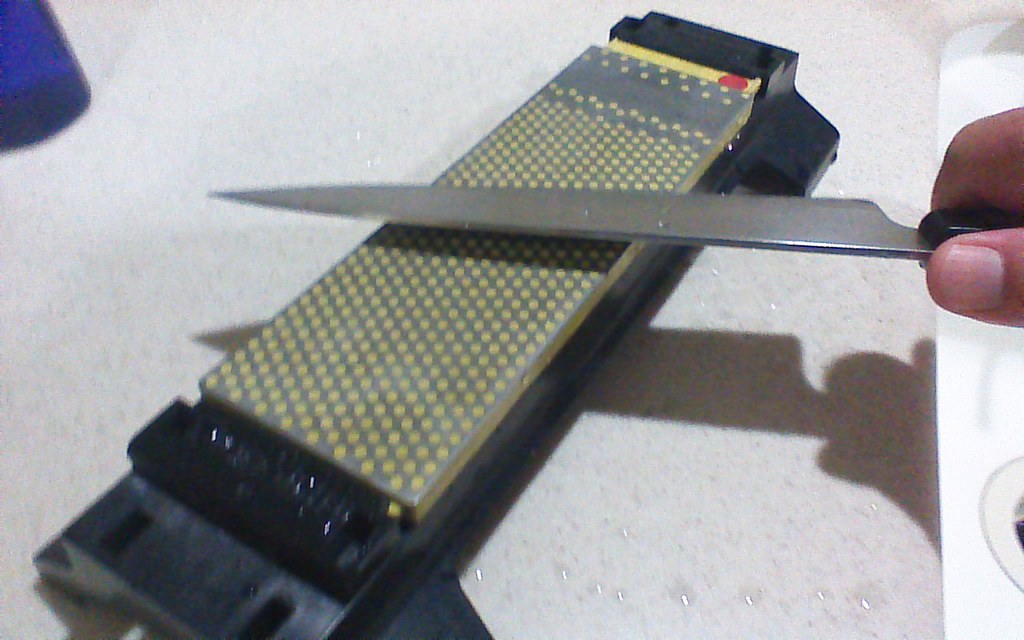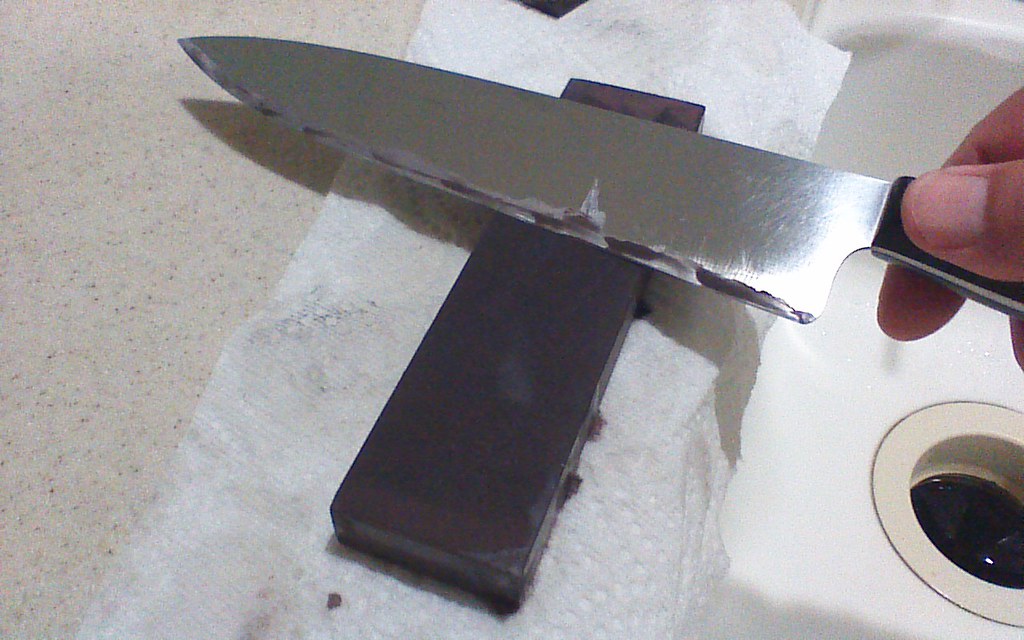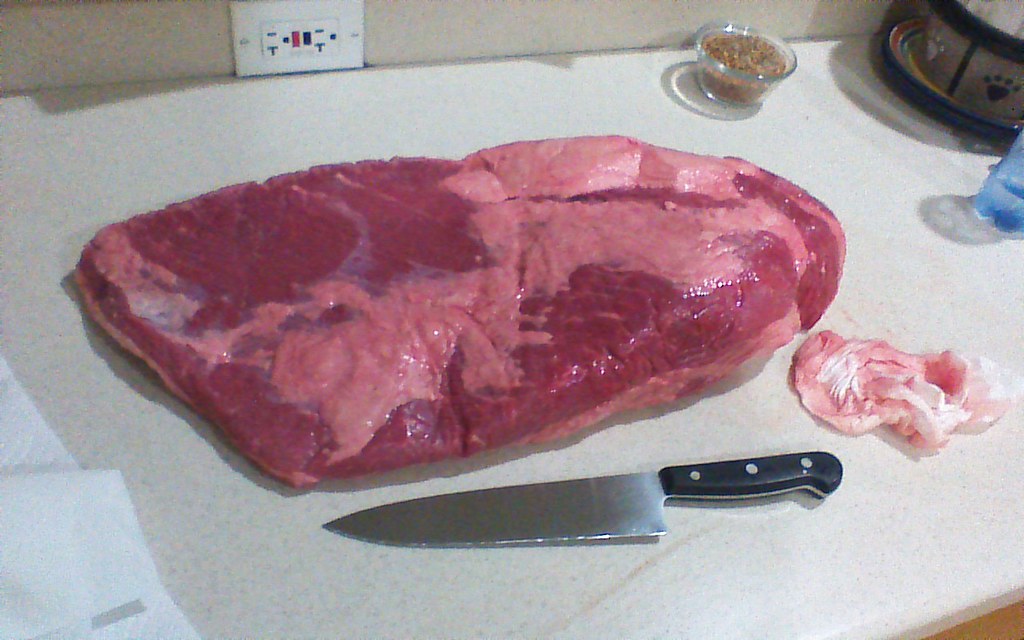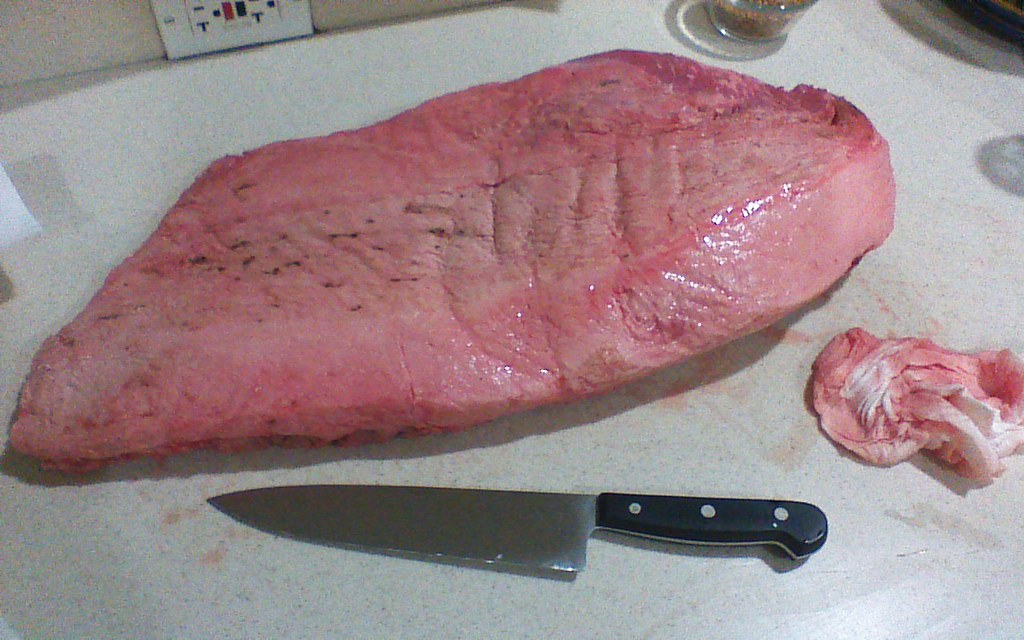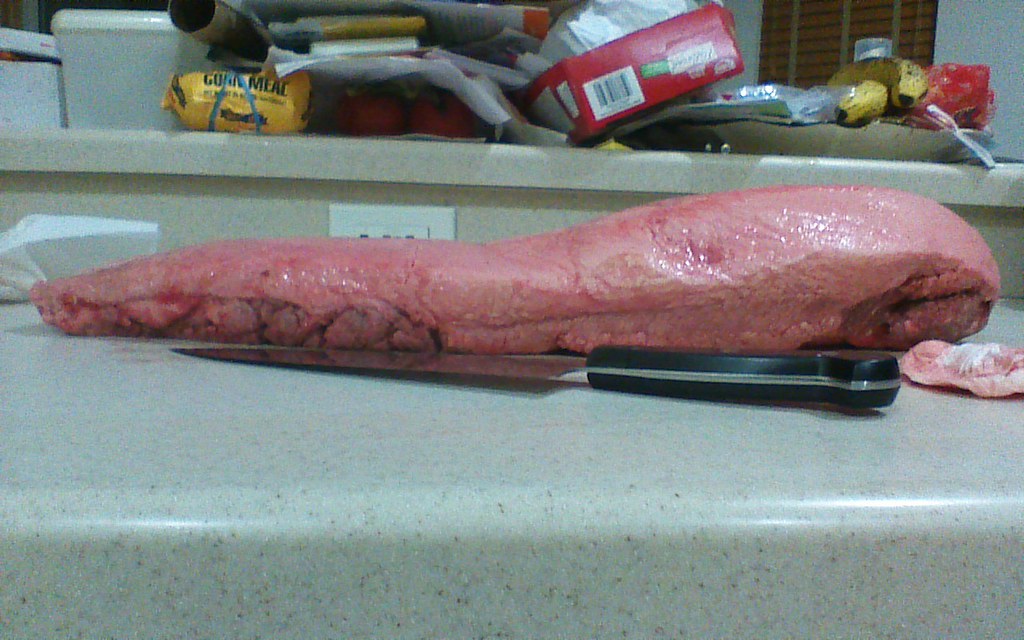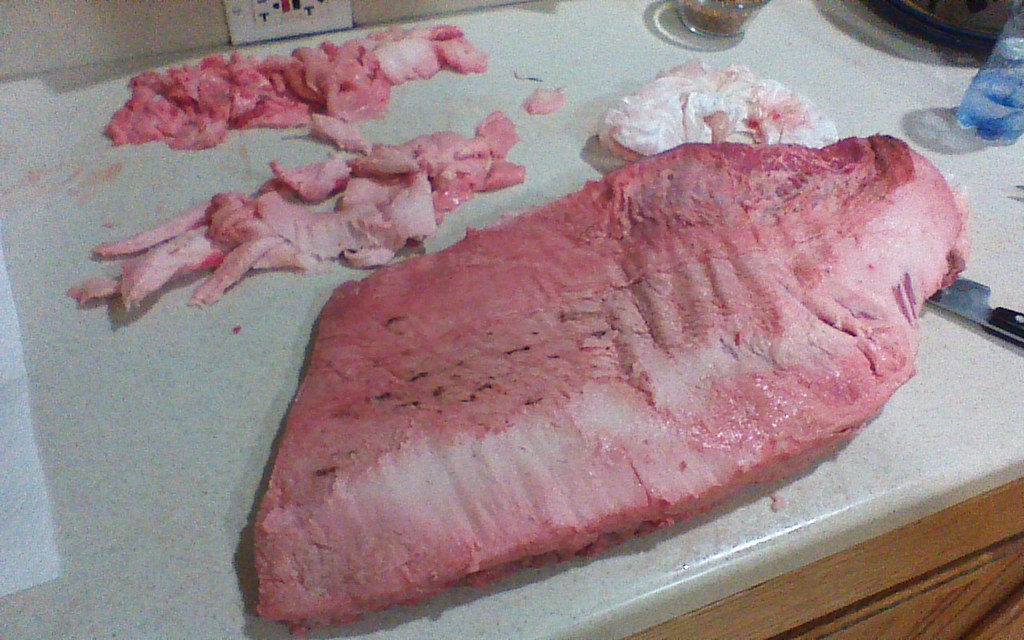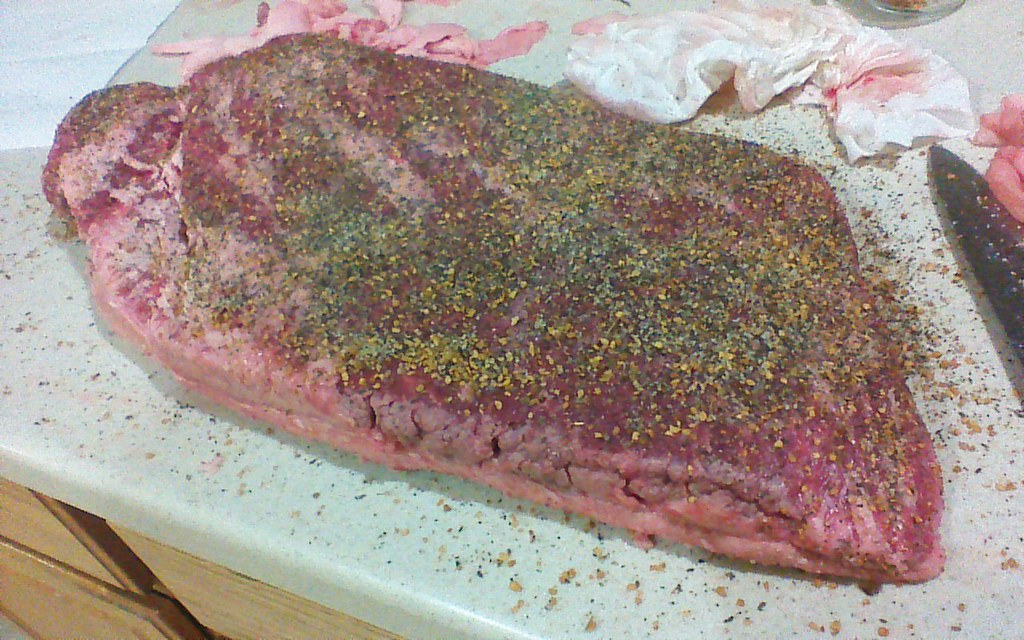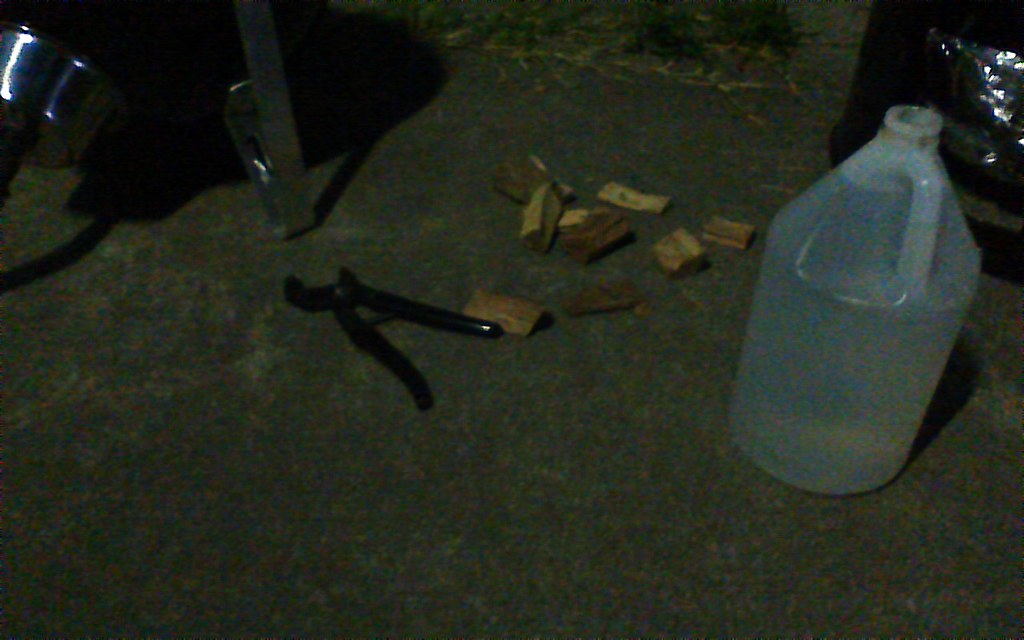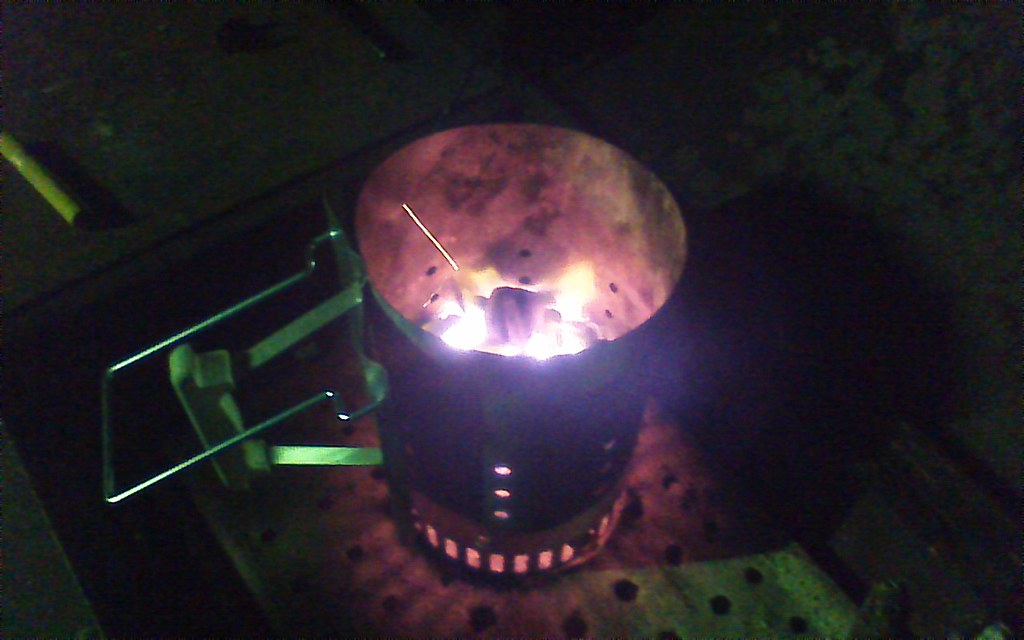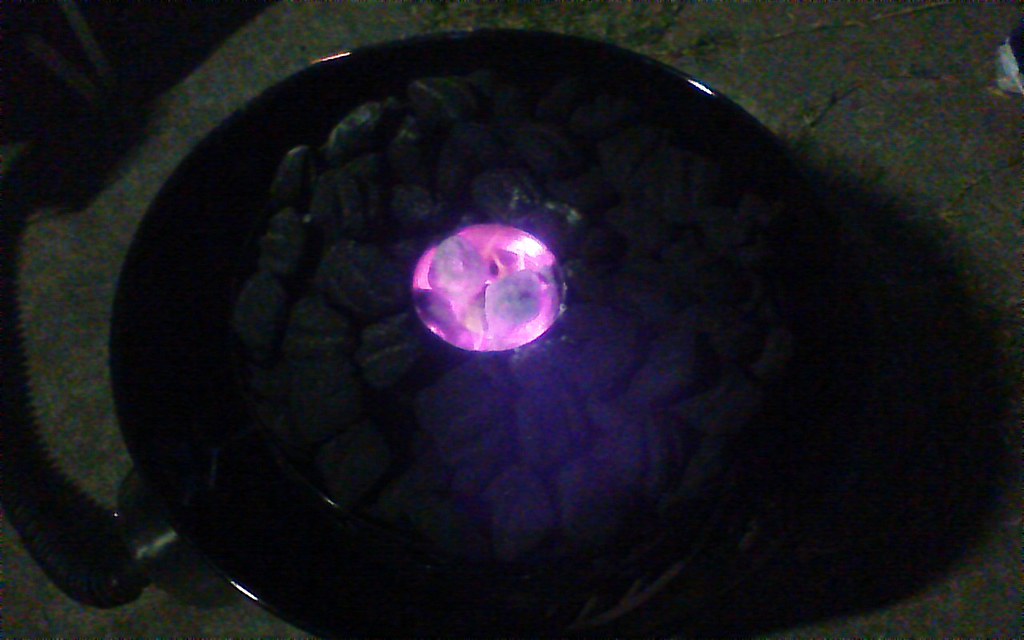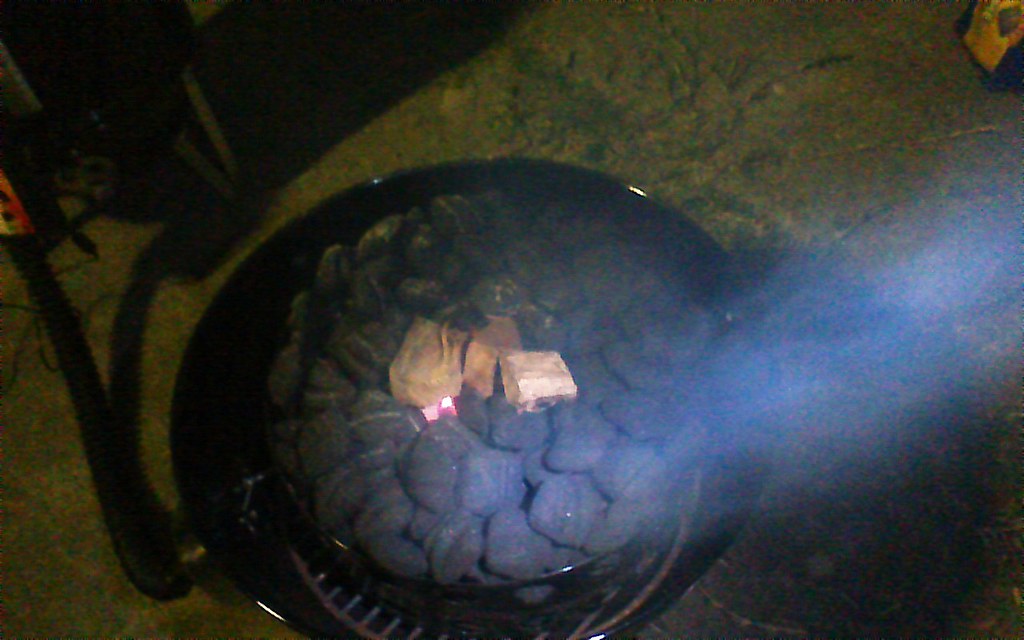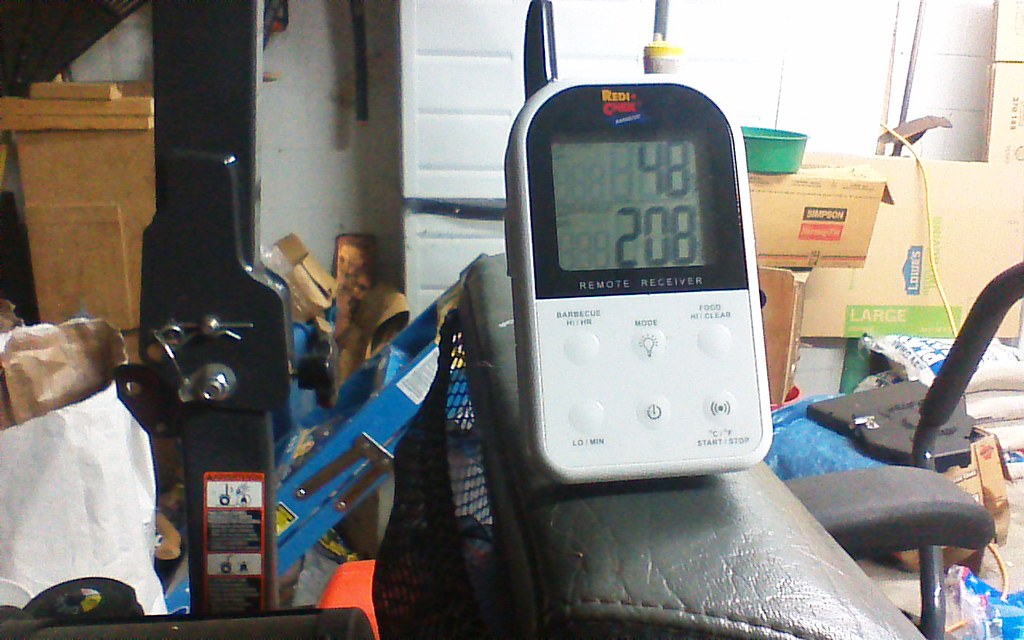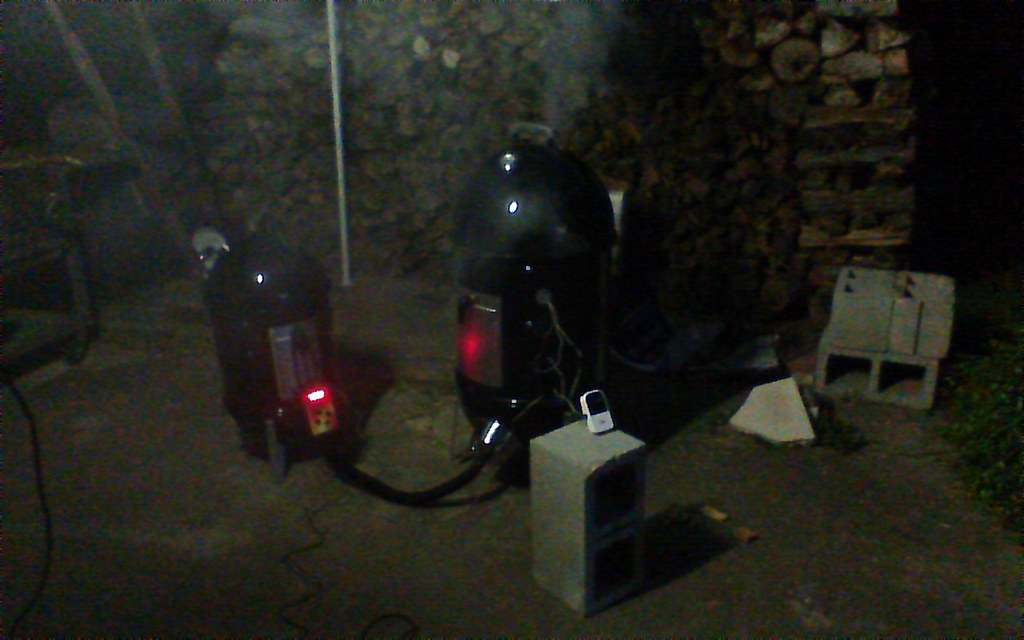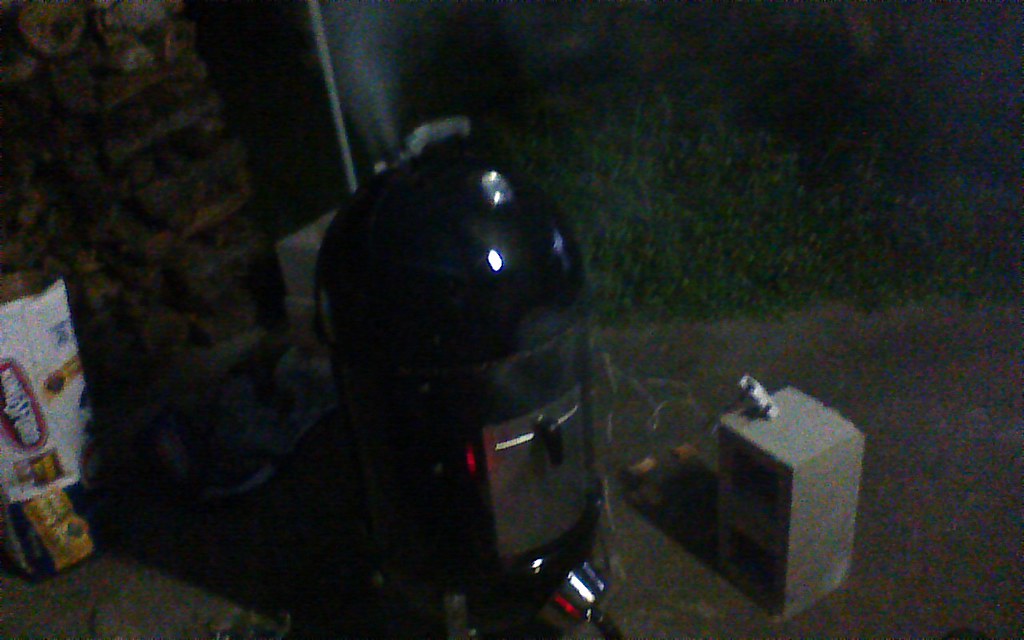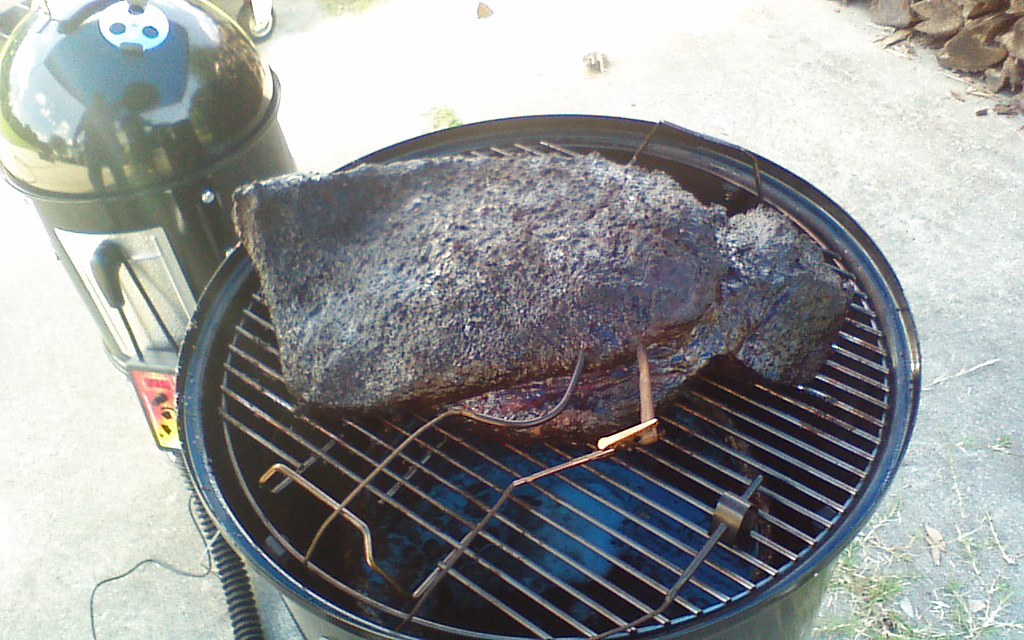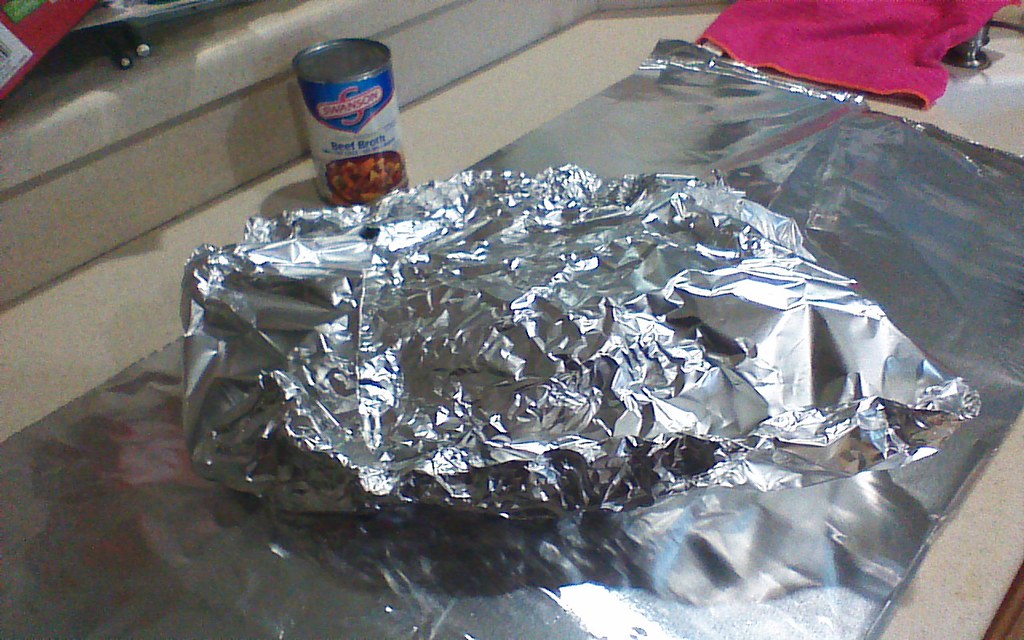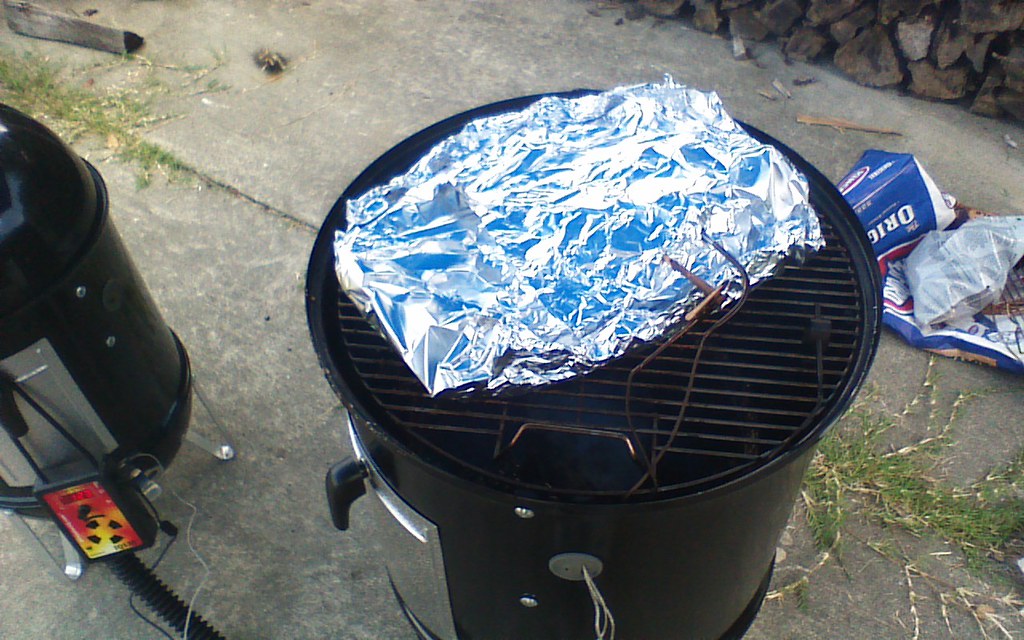Jake Wilson
TVWBB Fan
Picked up this packer yesterday (Thursday)...

here's the fat cap side-
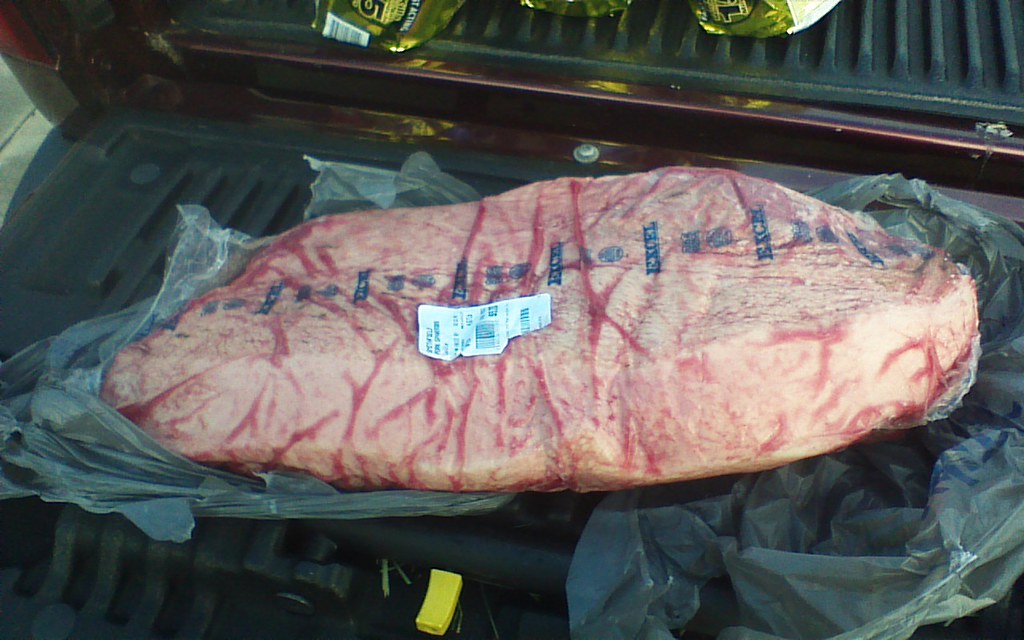
Relative smoking n00b here= ...I have three pork spare rib cooks under my belt on my 14.5 WSM, and this will be the second cook on my 18.5 WSM, the first being a leg quarter roast (chicken) I've yet to post. I say roast as I forgot to add wood to the coals=:-(...imagine that
...I have three pork spare rib cooks under my belt on my 14.5 WSM, and this will be the second cook on my 18.5 WSM, the first being a leg quarter roast (chicken) I've yet to post. I say roast as I forgot to add wood to the coals=:-(...imagine that
This WSM 18.5 has had several fat only smokes on it before doing up the chicken about a week ago so I suspect it's close to somewhat seasoned and is what it is. Ready or not, here comes a brisket
I thought I would have gone for a pork butt for my next cook, seeing how I've done pork ribs a few times and the chicken leg quarters once. Going for a brisket for my fifth ever cook on WSM's to me seems courageous, but as fate would have it, I just so happened to be in a Wal-Mart for other things and had an idea they would have a brisket in stock, and there it was, it called out my name= BTW, at this writing, I have not ever had brisket (true!), so this will be my first taste!
BTW, at this writing, I have not ever had brisket (true!), so this will be my first taste!
The grocery I normally shop at does not carry packers at all. They stock the flats and cut them in half, wrap them and then set em out for sale (Publix, Foxwood, Ocala Fla.). My short time here in the WSM realm and smoking meat in general, I've considered smoking brisket the holy grail of BBQ, in that I've read it's not the easiest cut of meat to pull off successfully, ending up done to perfection, so I'm aiming high=
Here's my plan...sort of= , and I'm open to other ideas but basically I'm figuring on 1 to 1.5 hours per pound to get er' done. This packer is just shy of 15 lbs. so I'm thinking 15 hours at the minimum to cook. Does that sound about right? I'm planning on trying to keep/hold the temps at around 250 degrees Fahrenheit
, and I'm open to other ideas but basically I'm figuring on 1 to 1.5 hours per pound to get er' done. This packer is just shy of 15 lbs. so I'm thinking 15 hours at the minimum to cook. Does that sound about right? I'm planning on trying to keep/hold the temps at around 250 degrees Fahrenheit
I purchased a Pitmaster IQ 120 several weeks ago which I've yet to use. Prudence may dictate testing it out on another less pricey cook but I'm not sure if I can schedule this smoke to start and finish when I'm normally up and awake, so if any of you have experience with this particular automatic temperature controller on an 18.5 WSM, I'm all ears= The weekend is rolling around so I have time to plan this a little more. I'm not cooking this brisket for a group or an event so no pressure there, to get it right (for an audience)
The weekend is rolling around so I have time to plan this a little more. I'm not cooking this brisket for a group or an event so no pressure there, to get it right (for an audience)
What about the water pan...should I use it for this cook?, and if so, Minnion Method or not? I think it could work out either way, smoking it dry or using water, but I'm leaning to use the water pan, primarily because when I watched Franklin on U-Tube smoke one, he used a pan of water in his cooker though his cooker (the one he used) is a horizontal off set with a wood fire box, totally different from the gear I will be using. I believe Franklin used the pan of water, between the point and the fire, so the water pan acted like a buffer, so the point wouldn't burn up, and why I am thinking using the water pan in my 18.5 WSM would be a good idea...
I'm also planning on putting the trimmed fat cap down (meat side up), to protect the meat from the heat that emanates from below
Let's see...what else?...I'll make sure I trim it so the fits= I haven't done any measuring but if meat needs to be trimmed to get it to fit onto the grill, the trim will come off the flat, or at least that is the plan, and if I have to trim, I'm thinking it would be wise to place that trimmed meat somewhere in the cooker for snacks
I haven't done any measuring but if meat needs to be trimmed to get it to fit onto the grill, the trim will come off the flat, or at least that is the plan, and if I have to trim, I'm thinking it would be wise to place that trimmed meat somewhere in the cooker for snacks
For the rub ingredients, at this point, like Franklin, I'm thinking equal parts salt and pepper only
I have plenty of charcoal...we stopped at Home Depot before heading home and although I stayed in the truck and sent Helen in (she had stuff she wanted to get and I needed a couple of winks), I think she got the sale price going on Kingsford I read about in another thread, that's going on there at least through this weekend. I love sales..she does too but she's not in a charcoal collection/hoarding mindset as she didn't mention anything about the price. heck ,if it was me going in there and seeing half off, I would have purchased quite a bit. Sorry, but I digress=
I've come to gather with brisket, to let it roll uncovered till it hits 165 degrees (I have and will be using a Maverick ET 732 Thermometer w/the meat probe), or until there is a respectable bark formed, that won't come off using a finger nail to scrape... so if and when I have the bark, pull the brisket and wrap in butcher paper or tin foil till done (190-200 degrees f?) I like the idea of bending the brisket to determine doneness, although I've yet to smoke one so I have no idea...but I was wondering, since I failed to score a thermapen, and I have the Maverick to keep an eye on final temps, is it possible to leave the meat temp probe in the flat when I wrap it?...this point seems hazy to me. Any videos I've ever watched where brisket is smoked, I don't recall seeing them leave a temp probe in the meat and then wrap it, after the bark has formed...Oh!, and I planned on inserting the meat temp probe into the flat, from the side, just behind the point
Okay, am I missing anything?...let the comments fly, I'll be watching and will appreciate anything coming from this fine group's empirical knowledge and superior tutelage
Best,
Jake
Reddick Fla.

here's the fat cap side-

Relative smoking n00b here=
This WSM 18.5 has had several fat only smokes on it before doing up the chicken about a week ago so I suspect it's close to somewhat seasoned and is what it is. Ready or not, here comes a brisket
I thought I would have gone for a pork butt for my next cook, seeing how I've done pork ribs a few times and the chicken leg quarters once. Going for a brisket for my fifth ever cook on WSM's to me seems courageous, but as fate would have it, I just so happened to be in a Wal-Mart for other things and had an idea they would have a brisket in stock, and there it was, it called out my name=
The grocery I normally shop at does not carry packers at all. They stock the flats and cut them in half, wrap them and then set em out for sale (Publix, Foxwood, Ocala Fla.). My short time here in the WSM realm and smoking meat in general, I've considered smoking brisket the holy grail of BBQ, in that I've read it's not the easiest cut of meat to pull off successfully, ending up done to perfection, so I'm aiming high=
Here's my plan...sort of=
I purchased a Pitmaster IQ 120 several weeks ago which I've yet to use. Prudence may dictate testing it out on another less pricey cook but I'm not sure if I can schedule this smoke to start and finish when I'm normally up and awake, so if any of you have experience with this particular automatic temperature controller on an 18.5 WSM, I'm all ears=
What about the water pan...should I use it for this cook?, and if so, Minnion Method or not? I think it could work out either way, smoking it dry or using water, but I'm leaning to use the water pan, primarily because when I watched Franklin on U-Tube smoke one, he used a pan of water in his cooker though his cooker (the one he used) is a horizontal off set with a wood fire box, totally different from the gear I will be using. I believe Franklin used the pan of water, between the point and the fire, so the water pan acted like a buffer, so the point wouldn't burn up, and why I am thinking using the water pan in my 18.5 WSM would be a good idea...
I'm also planning on putting the trimmed fat cap down (meat side up), to protect the meat from the heat that emanates from below
Let's see...what else?...I'll make sure I trim it so the fits=
For the rub ingredients, at this point, like Franklin, I'm thinking equal parts salt and pepper only
I have plenty of charcoal...we stopped at Home Depot before heading home and although I stayed in the truck and sent Helen in (she had stuff she wanted to get and I needed a couple of winks), I think she got the sale price going on Kingsford I read about in another thread, that's going on there at least through this weekend. I love sales..she does too but she's not in a charcoal collection/hoarding mindset as she didn't mention anything about the price. heck ,if it was me going in there and seeing half off, I would have purchased quite a bit. Sorry, but I digress=
I've come to gather with brisket, to let it roll uncovered till it hits 165 degrees (I have and will be using a Maverick ET 732 Thermometer w/the meat probe), or until there is a respectable bark formed, that won't come off using a finger nail to scrape... so if and when I have the bark, pull the brisket and wrap in butcher paper or tin foil till done (190-200 degrees f?) I like the idea of bending the brisket to determine doneness, although I've yet to smoke one so I have no idea...but I was wondering, since I failed to score a thermapen, and I have the Maverick to keep an eye on final temps, is it possible to leave the meat temp probe in the flat when I wrap it?...this point seems hazy to me. Any videos I've ever watched where brisket is smoked, I don't recall seeing them leave a temp probe in the meat and then wrap it, after the bark has formed...Oh!, and I planned on inserting the meat temp probe into the flat, from the side, just behind the point
Okay, am I missing anything?...let the comments fly, I'll be watching and will appreciate anything coming from this fine group's empirical knowledge and superior tutelage
Best,
Jake
Reddick Fla.

